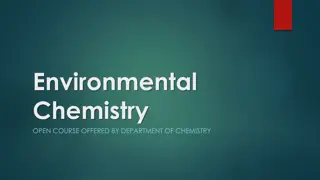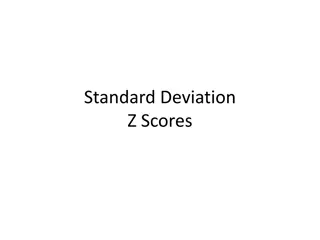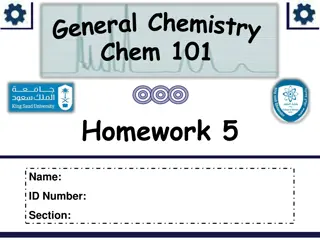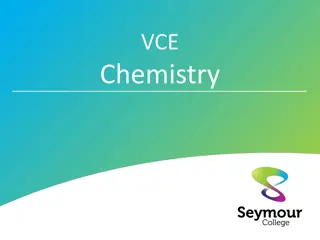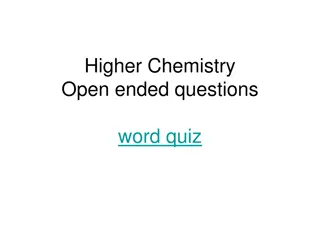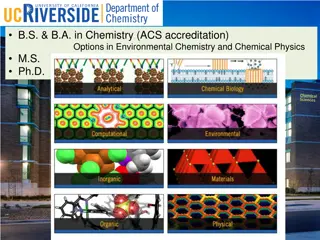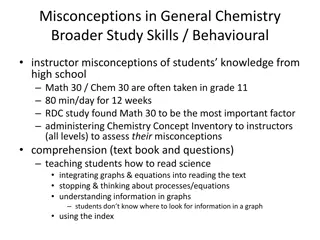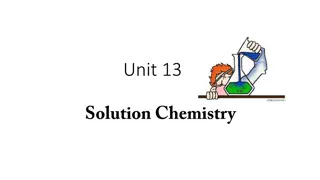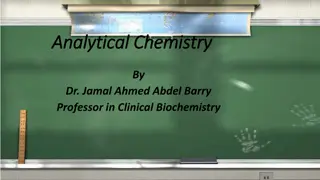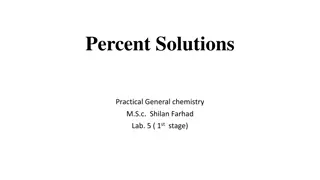Understanding Standard Solutions in Chemistry
Definitions of terms like solute, solvent, and saturation are explained. The importance of preparing standard solutions, methods for their preparation, and how results are expressed are discussed. Stock solutions and their benefits are also covered. Images are used for illustration throughout the content.
Download Presentation

Please find below an Image/Link to download the presentation.
The content on the website is provided AS IS for your information and personal use only. It may not be sold, licensed, or shared on other websites without obtaining consent from the author. Download presentation by click this link. If you encounter any issues during the download, it is possible that the publisher has removed the file from their server.
E N D
Presentation Transcript
Lecture 2. Preparation of Standard solutions and expression of results By: Dinaol 4/28/2020 1
In this Lecture Definitions of some terms Definitions of standard solutions Why we need to prepare standard solutions Methods of Preparing standard solutions (Some calculations) How to express the results of our test 4/28/2020 2
Definitions of related terms Solutions Homogeneous mixtures that are mixed so thoroughly that neither component can be observed independently of the other. Homogeneous mixture composed of two or more substances. In such a mixture, a solute is dissolved in another substance, known as a solvent. Solvent The major component of solutions. The substance which dissolves another to form a solution Solute The minor component of a solutions The substance which dissolves in a solution 4/28/2020 3
Definitions of related terms Saturation Saturation is the point at which a solution of a substance can dissolve no more of that substance and additional amounts of it will appear as a precipitate. Supersaturation It refers to a solution that contains more of the dissolved material than could be dissolved by the solvent under normal circumstances. 4/28/2020 4
Definitions of related terms Stock solutions A stock solution is a concentrated solution that will be diluted to some lower concentration for actual use. Stock solutions are used to save preparation time, conserve materials, reduce storage space, and improve the accuracy with which working lower concentration solutions are prepared. 4/28/2020 5
Definition of Standard Solutions What is Standard Solutions? A standard solution is any chemical solution which has a precisely known concentration. Similarly, a solution of known concentration has been standardized. To prepare a standard solution, a known mass of solute is dissolved and the solution is diluted to a precise volume. Standard solution concentration is usually expressed in terms of molarity (M) or moles per liter (mol/L). 4/28/2020 6
Why we need to prepare Standard Solutions? You use a standard solution to determine the concentration of the analyte during laboratory tests. 4/28/2020 7
What must be considered during preparation of standard solution? The nature of solute Must be pure (analytical grade) Example, Oxalic acid , K2Cr2O7 The quality we need/expect at the end Not all substances are suitable solutes for standard solutions. The reagent must be stable, pure, and preferably of high molecular weight. 4/28/2020 8
Solutions recipes: Where do they come from? Original Scientific Literature Lab manuals (instructional) Lab Manuals (professional) Handbooks Manufacturers and suppliers 4/28/2020 9
Concentration Versus Amount CONCENTRATION -- amount / volume Fraction where: Numerator, the amount of solute Denominator, usually volume of entire solution solvent + solute(s) 4/28/2020 10
Each star represents 1 mg of NaCl. What is the total amount of NaCl in the tube? _____ What is the concentration of NaCl in the tube (in mg/mL)? _____ 4/28/2020 11
Each star represents 1 mg of NaCl. What is the total amount of NaCl in the tube? 4 mg What is the concentration of NaCl in the tube (in mg/mL)? 4 mg = ?_ 5 mL 1 mL ? = 0.8 mg,so the concentration is 0.8 mg/mL Figure 1. 4/28/2020 12
Ways To Express Concentration Of Solute Source of confusion: more than one way to express concentration of solute in a solution 4/28/2020 13
Concentration Expressions (Most Common) WEIGHT PER VOLUME MOLARITY PERCENTS (Three kinds) a. Weight per Volume % (w/v %) b. Volume per Volume % (v/v %) c. Weight per Weight % (w/w %) 4/28/2020 14
Percents Percents X % is a fraction numerator is X denominator is 100 Three variations on this theme. 4/28/2020 15
Weight/volume Weight/volume % % TYPE I: Grams of solute 100 mL total solution Most common in biology but seldom used in chemistry manuals Technically, the units should be the same in the numerator and denominator 4/28/2020 16
Example 20 g of NaCl in 100 mL of total solution = 20% (w/v) solution. 4/28/2020 17
Example: By Proportions How would you prepare 500 mL of a 5 % (w/v) solution of NaCl? 4/28/2020 18
Answer, By Proportions 5 % = 5 g 100 mL = ? By definition: 5 g 100 mL 500 mL ? = 25 g = amount of solute BTV 500 mL 4/28/2020 19
By Equation How would you prepare 500 mL of a 5 % (w/v) solution of NaCl? 1.Total volume required is 500 mL. 2. 5% = 0.05 3. (0.05) (500 mL) = 25 4. 25 is the amount of solute required in grams. 5. Weigh out 25 g of NaCl. Dissolve it in less than 500 mL of water. 6. In a graduated cylinder or volumetric flask, bring the solution to 500 mL. 4/28/2020 20
4/28/2020 21
Concentration Expressions (Most Common) PARTS (Common in environmental sciences, for example) Amounts of solutes expressed as "parts" a. Parts per Million (ppm) b. Parts per Billion (ppb) c. Might see parts per Thousand (ppt) 4/28/2020 22
Parts Parts may have any units but must be the same for all components of the mixture. 4/28/2020 23
Example: A solution is 3:2:1 ethylene:chloroform:isoamyl alcohol Might combine: 3 liters ethylene 2 liters chloroform 1 liter isoamyl alcohol 4/28/2020 24
Two Other Forms Of % v/v mL solute 100 mL solution w/w g solute 100 g solution 4/28/2020 25
Weight/weight How would you make 500 g of a 5% solution of NaCl by weight (w/w)? 4/28/2020 26
Answer Percent strength is 5% w/w, total weight desired is 500g. 5% = 5g/100g 5g X 500 g = 25 g = NaCl needed 100 g 500 g 25 g = 475 g = amount of solvent needed Dissolve 25 g of NaCl in 475 g of water. 4/28/2020 27
Weight / Volume Means a fraction with: weight of solute in numerator total volume in denominator 4/28/2020 28
Example: 2 mg/mL proteinase K Means 2 mg of proteinase K in each mL of solution. Example: How much proteinase K is required to make 50 mL of solution at a concentration of 2 mg/mL? 4/28/2020 29
Can Solve as A Proportion Problem 2 mg proteinase K = 1 mL solution 50 mL solution X X = 100 mg = amount proteinase K needed. 4/28/2020 30
Volume / Volume Means a fraction with: volume of solute in numerator total volume in denominator Usually the solute here is a liquid as well Remember that volume in the denominator is the total volume of the solution 4/28/2020 31
Example You are to make 50 mL of a 8% v/v solution of diluted dish soap. How many mLs of concentrated dish soap must be added to how many mLs of water? 4/28/2020 32
Weight / Weight Means a fraction with: mass of solute in numerator total mass in denominator Most times the solute here is a solid and sometimes the solution is also a solid Remember that mass in the denominator is the total mass of the solution 4/28/2020 33
Examples You are to prepare 4 kg of specific soil sample which is to be 8% w/w sand and 5% w/w clay in which the remainder is top soil. How many grams of each sand and clay need to be added to the soil to make the solution? 4/28/2020 34
Ppm And Ppb ppm: The number of parts of solute per 1 million parts of total solution. ppb: The number of parts of solute per billion parts of solution. 4/28/2020 35
Ppm Example: 5 ppm chlorine = 5 g of chlorine in 1 million g of solution, or 5 mg chlorine in 1 million mg of solution, or 5 pounds of chlorine in 1 million pounds of solution 4/28/2020 36
Conversions To convert ppm or ppb to simple weight per volume expressions: 5 ppm chlorine 4/28/2020 37
Conversions To convert ppm or ppb to simple weight per volume expressions: 5 ppm chlorine = 5 g chlorine = 5 g chlorine 106 g water 106 mL water = 5 mg/1 L water = 5 X 10-6 g chlorine/ 1 mL water = 5 micrograms/mL 4/28/2020 38
PPM To Micrograms/ml For any solute: 1 ppm in water = 1 microgram mL 4/28/2020 39
Each star represents 1 mg of dioxin. What is the concentration of dioxin in the beaker expressed as ppm (parts per million)? ____________ What is the total amount of dioxin in beaker? ___________ 4/28/2020 40
Each star represents 1 mg of dioxin. What is the total amount of dioxin in tube? 25 mg What is the concentration of dioxin in tube expressed as ppm? ____________ 1 ppm in water = 1 g mL 25 mg/500 mL = 0.05 mg/mL= 50 g/mL so the concentration is 50 ppm 4/28/2020 41
Still More Concentration Expressions TYPES NOT COMMON IN BIOLOGY MANUALS: MOLALITY NORMALITY 1.We remember that for NaOH and HCl, molarity = normality, however, this is not true for all solutes 4/28/2020 42
More with Molarity Molarity is: number of moles of a solute that are dissolved per liter of total solution. By definition: A 1 M solution contains 1 mole of solute per liter total volume. 4/28/2020 43
Mole Mole How much is a mole? 4/28/2020 44
Examples: Water, Sulfuric Acid and Glucose For a particular compound, add the atomic weights of the atoms that compose the compound. What is the formula weight for water H2O? What is the formula weight for sulfuric acid H2SO4? What is the formula weight for glucose C6H12O6? 4/28/2020 45
Example: Sulfuric Acid For a particular compound, add the atomic weights of the atoms that compose the compound. H2SO4: 2 hydrogen atoms 2 X 1.00 g = 2.00 g 1 sulfur atom 1 X 32.06 g = 32.06 g 4 oxygen atoms 4 X 16.00 g = 64.00 g 98.06 g/mole Glucose = 180 g/mole 4/28/2020 46
Example Continued A 1M solution of sulfuric acid contains 98.06 g of sulfuric acid in 1 liter of total solution. Observe that "mole" is an expression of amount Molarity" is an expression of concentration. 4/28/2020 47
Definitions "Millimolar", mM, millimole/L. A millimole is 1/1000 of a mole. "Micromolar", M, mole/L. A mole is 1/1,000,000 of a mole. 4/28/2020 48
Formula HOW MUCH SOLUTE IS NEEDED FOR A SOLUTION OF A PARTICULAR MOLARITY AND VOLUME? FW X molarity x volume = g solute needed 4/28/2020 49
Example How much solute is required to make 300 mL of 0.8 M CaCl2? 4/28/2020 50





